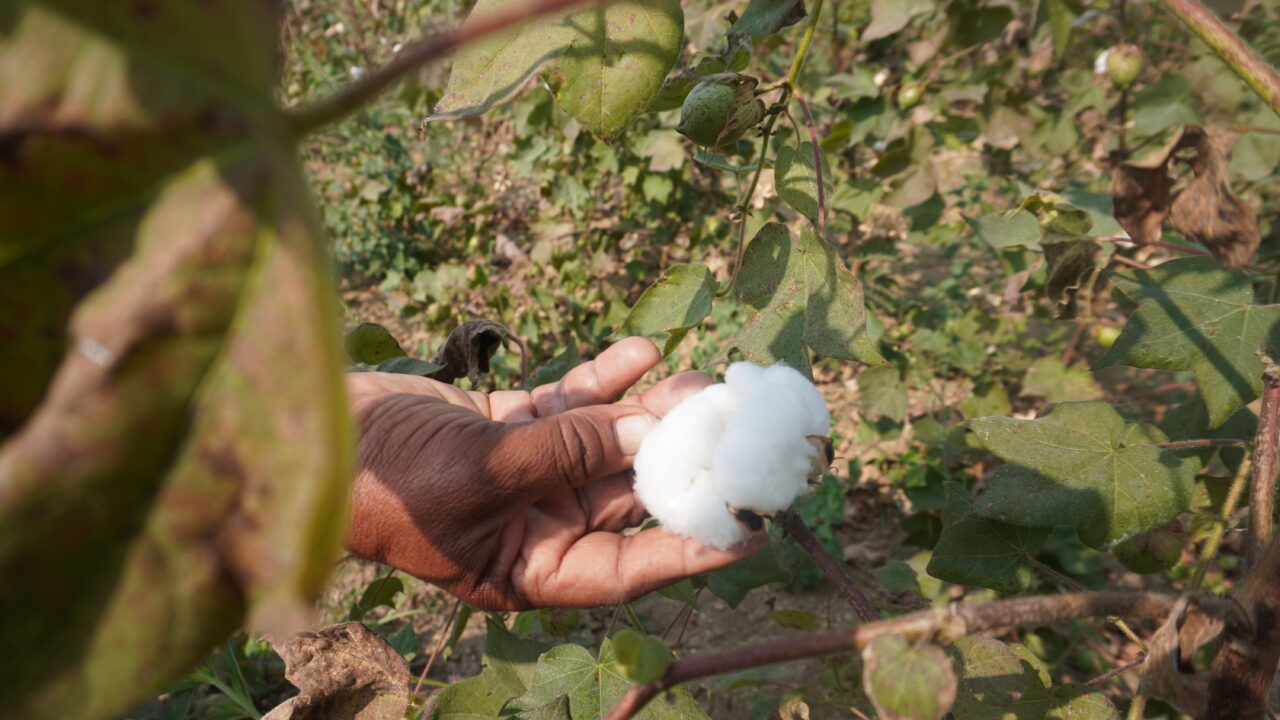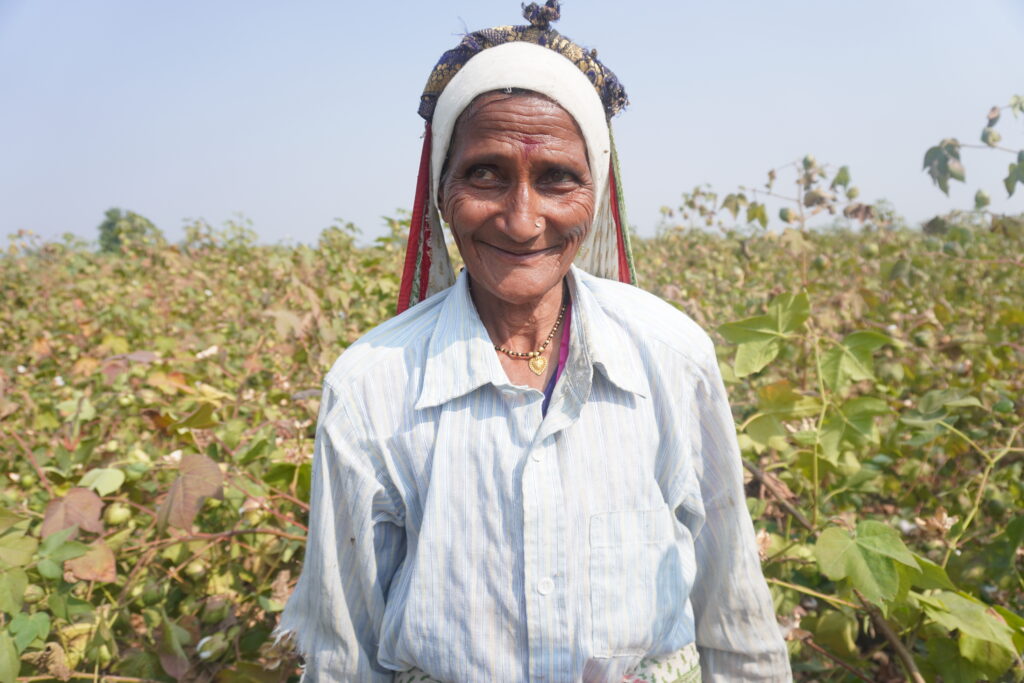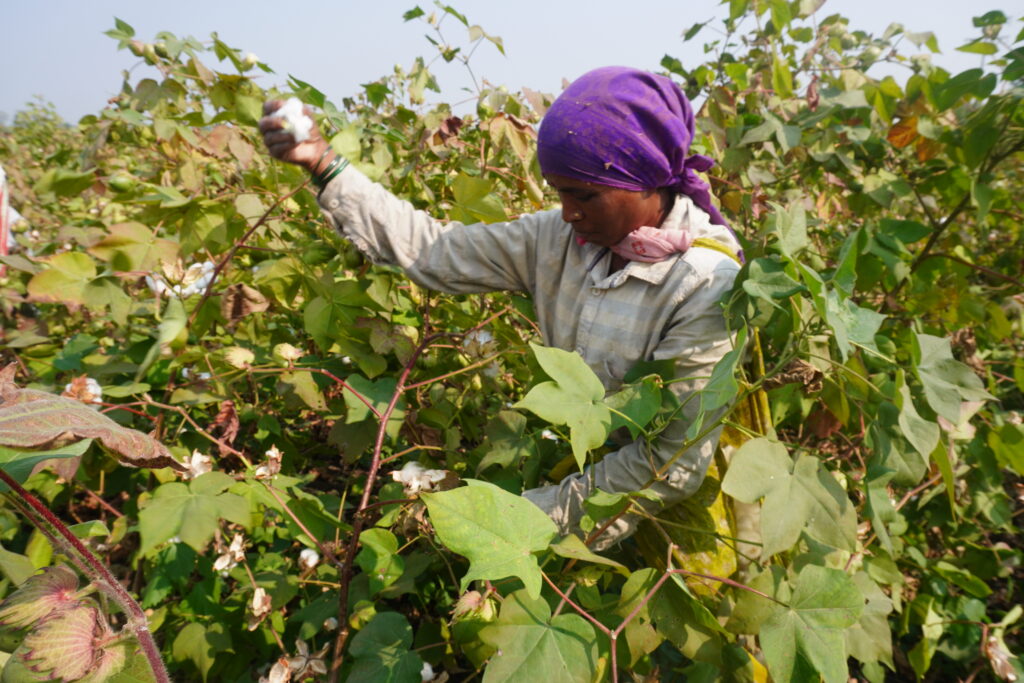Letter from Wabgaon: Crisis in India’s Cotton Country
As men leave the drought-wracked countryside in search of better pay, the backbreaking production of the world’s second largest cotton harvest has become “women’s work.”
WABGAON, INDIA — In India’s agricultural economy, the harvesting seasons are traditionally marked with festivities. But the December cotton harvest in central India’s Maharashtra State has become a somber time in recent years.
Around 50 miles from the city of Nagpur, near the center of the subcontinent, the village of Wabgaon looked like a ghost town during a visit at the peak of last year’s reaping. Houses appeared deserted, their doors and windows closed. The only signs of life were in the fields outside the village, where women of all ages could be seen plucking small balls of cotton in the scorching sun.
“Where are the men?” I asked an elderly woman.
“Migrated for work to other states,” she replied, continuing to pluck the white tufts. In earlier years, 50-year-old Indu Laxmanrao Darane’s husband and sons would join her in the fields. “We would be able to manage the household expenses with ease,” she said. But after her sons wed and the men all moved away seeking better opportunities, she is left to work the land with her daughters-in-law. Both of Darane’s sons migrated first to the nearest city of Nagpur before moving on to the neighboring state of Madhya Pradesh.
The heat that unusually hot December afternoon would have broken anyone’s spirits, but Darane couldn’t afford to pause. A daily wage worker since her teens, she was dressed in a torn and faded white shirt that she used to wipe her brow. She had tied a long cloth around her head with a pouch hanging at her upper back into which she deftly placed the cotton. She was tall but feeble and her sun-worn face belied her age.
While machines have picked nearly all the cotton in the U.S. for 50 years or more, the backs and hands of women like Darane are the engines of cotton farming in India.
Darane said she earns about $3 per day, working seven days a week. “Do you think this is a fair wage considering the heat?” she asked. She also remarked on the banes of the thorny cotton plant, which the enslaved people of the U.S. described at length in their monographs and reports of the cotton economy of the American South.
India is the world’s largest cotton producer and the second-largest cotton exporting country after China. Its 42,000 square miles under cotton cultivation — an area bigger than the U.S. state of Tennessee — is the largest in the world. Cotton accounts for 59% of the raw materials used in the textile industry in India, and supports the livelihoods of 5.8 million cotton farmers and approximately 50 million more workers in associated industries.
While machines have picked nearly all the cotton in the U.S. for 50 years or more, the backs and hands of women like Darane are the engines of cotton farming in India. A harvester is an exorbitant investment for most Indian farmers, while human labor remains cheap. According to the International Trade Center, women do 70% of planting and 90% of the picking of India’s cotton harvest of around 13.4 billion pounds, which is 30% larger than the U.S. harvest.
Nitya Rao, professor in the School of Global Development at University of East Anglia in England, recently published a study of Indian agriculture that included Darane’s district. Rao found that although working in agriculture has the potential for positive outcomes for women in India, the overall effects on nutrition for women and their children are negative.
The nursing child depends on the mother’s time for breastfeeding and supplementary feeding, but the double burden of work and child care often leads to a trade-off between the two. Longer working hours or increased work intensity, meanwhile, can have detrimental effects on the women’s own health, cascading to affect their children’s health as their ability to care for their children is compromised. In Wabgaon, several women noted that dust in the fields causes headaches by the time they are finished with the day’s work, draining their desire to cook for their children or even to eat. Climate change is likely to exacerbate these conditions, with rising temperatures and unreliable rainfall making farming even riskier.

“Agriculture in India has mostly been a household enterprise with contributions from both men and women,” Rao said. But that’s now changing as a result of an adaption strategy that places new burdens on women. “Since they are already working as homemakers,” Rao said, the new dynamic effectively “doubles their workload.”
Women now spend 80%-to-90% of farming days in the fields, with men’s contribution down to 10%-20%, according to the United Nations Food and Agriculture Organization. Their wages, meanwhile, are just 50%-to-75% as much, while they perform household chores and care for family livestock with little or no help from men living for extended periods in distant cities. Of 73 countries studied in a report by International Labor Organization, India’s pay gap was highest. While 70% of farmers are women, they own only 13% of the land.
The FAO estimates that if India’s women farmers had income, health care and nutrition equal to those of men, agriculture yields could improve by as much as 20%-to-30%.
But under the new climate conditions, exploitation of women seems likely to grow.
Darane’s family does not own land, yet as a wage laborer she is no less dependent on the success of the cotton crop. As crop failures of the past decade have trapped landowners in a cycle of debt, the effects trickle down to laborers like her.
Cotton requires uniform temperature and sufficient rainfall in the early stages of growth, and sunny and dry weather after flowering. A weak or late monsoon in India can reduce cotton supplies and affect world cotton prices; conversely, after a strong monsoon, the resulting surplus of Indian cotton turns into exports that compete on the global market, depressing prices.
The FAO estimates that if India’s women farmers had income, health care and nutrition equal to those of men, agriculture yields could improve by as much as 20%-to-30%.
February 2022 was India’s hottest February in 146 years. This fit a pattern: India witnessed 280 heat waves across 16 states that year — the most since 2010. According to a study from the World Meteorological Association, the likelihood of similar heat waves occurring in India has increased by 30 times since the pre-industrial era. Last year’s heat waves were followed by an early and severe monsoon season that devastated important cotton-growing states like Maharashtra and Gujarat. With cotton production down, laborers like Darane lost work.
Darane has noticed the changing climate. “The weather no longer plays in our favor,” she said. When warm weather is essential to sow seeds, it starts raining; when rain is needed, it becomes too hot for the crop to flourish.
Battered first by heat waves and then drought, Savita Raju Gande, 38, decided to stop cotton production altogether on her family’s one-acre land. With no income from the year’s crop, cultivation costs of around $363 would have forced the family to secure loans from the sellers, to be paid back after harvest — assuming the following year was better than the last.
“While my husband moved to Delhi in search of better wages, I continue to work here,” said Gande. Even with her responsibilities on the field doubled, after work she still must cook, clean, and, now that her husband is gone, tend to the cattle. Gande and her husband spend much of what they earn on education for their two daughters, believing it to be their path out of the exhausting cotton fields.

It’s a common predicament, said Dr Anjal Prakash, research director at the Bharti Institute of Public Policy at Hyderabad’s Indian School of Business. “With men migrating for better opportunities, this heightened workload strains women’s physical and mental health, limits economic opportunities and perpetuates gender inequalities” on top of the resource scarcity brought by climate change, he said. Addressing the imbalance will require “gender-sensitive policies that empower women economically, ensure access to education and healthcare and acknowledge their pivotal role in climate adaptation and mitigation.”
Revising policies to ensure equal pay, maternity support, accessible childcare, and safe workplaces would empower women, enhance their economic well-being and contribute to a more inclusive and equitable labor force, Prakash and Rao agreed. While such changes, and gender parity seem far off, conditions in the fields can be improved. Natural pesticides are more cost-effective, and don’t come with the health effects of some chemicals. Planting cover crops to nourish the soil of the cotton farms and moving toward bacteria-based natural fertilizer could also raise incomes.
In the meantime, Darane and Gande will toil again this harvest season under blistering heat. “Sometimes I just want to sleep,” Gande said, “but I have to push myself for the sake of my daughters.”
This reporting was supported by the International Women’s Media Foundation’s Howard G. Buffett Fund for Women Journalists.
Your support matters…Independent journalism is under threat and overshadowed by heavily funded mainstream media.
You can help level the playing field. Become a member.
Your tax-deductible contribution keeps us digging beneath the headlines to give you thought-provoking, investigative reporting and analysis that unearths what's really happening- without compromise.
Give today to support our courageous, independent journalists.
You need to be a supporter to comment.
There are currently no responses to this article.
Be the first to respond.